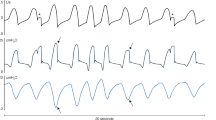Summary
Ventilatory responses to submaximal exercise loads indicate that in a population of 895 physically active and sedentary male and female subjects, exercise ventilation is inversely related to predicted VO2max. The correlation coefficients for males and females in this relationship are 0.61 (P<0.0001) and 0.26 (P<0.0001) respectively. The slopes of regression lines for V;E/VO2 and VO2max in female and male subjects are −2.59 and −0.91 respectively. This is associated with changes in composition of the expired air in that PCO2 increases and PO2 decreases with greater VO2max. The difference between the mean oxygen and carbon dioxide partial pressures in expired air of individuals in the highest and lowest VO2max ranges are 1.2 kPa (9 mm Hg) and 0.8 kPa (6 mm Hg) respectively.
Similar content being viewed by others
References
åstrand PO, Rodahl K (1970) Textbook of work physiology. McGraw-Hill, New York, pp 349–359
Byrne-Quinn E, Weil JV, Sodal IE, Filley GF, Grover RF (1971) Ventilatory control in the athlete. J Appl Physiol 30: 91–98
Collins DD, Scoggin CH, Zwillich CW, Weil JV (1978) Hereditary aspects of decreased hypoxic response. J Clin Invest 21: 105–110
Froelicher VF, Allen M, Lancaster MC (1974) Maximal treadmill testing of normal USAF aircrewmen. Aerospace Med 45: 310–315
Hirshman CA, McCullough RE, Weil JV (1975) Normal values for hypoxic and hypercapnic ventilatory drives in man. J Appl Physiol 38: 1095–1098
Maritz JS, Morrison JF, Peter J, Strydom NB, Wyndham CH (1961) A practical method of estimating an individual's maximum oxygen intake. Ergonomics 4: 97–119
Martin BJ, Weil JV, Sparks KE, McCullough RE, Grover RF (1978) Exercise ventilation correlates positively with ventilatory chemoresponsiveness. J Appl Physiol 45: 557–564
Martin BJ, Sparks KE, Zwillich CW, Weil JV (1979) Low ventilation in endurance athletes. Med Sci Sports Exerc 11: 181–185
Miyamura M, Yamashina T, Honda Y (1976) Ventilatory responses to CO2 rebreathing at rest and during exercise in untrained subjects and athletes. Jpn J Physiol 26: 245–254
Scoggin CH, Doekel RD, Kruger MH, Zwillich CW, Weil JC (1978) Familial aspects of decreased hypoxic drive in endurance athletes. J Appl Physiol: Respirat Environ Exercise Physiol 44: 464–468
Sheffield LT, Maloof JA, Sawyer JA, Roitman D (1978) Maximal heart rate and treadmill performance of healthy women in relation to age. Circulation 57: 79–84
Wolthuis RA, Froelicher FV, Fischer J, Triebwasser JH (1977) The response of healthy men to treadmill exercise. Circulation 55: 153–157
Author information
Authors and Affiliations
Rights and permissions
About this article
Cite this article
Morrison, J.F., van Malsen, S. & Noakes, T. Evidence for an inverse relationship between the ventilatory response to exercise and the maximum whole body oxygen consumption value. Europ. J. Appl. Physiol. 50, 265–272 (1983). https://doi.org/10.1007/BF00422165
Accepted:
Issue Date:
DOI: https://doi.org/10.1007/BF00422165




